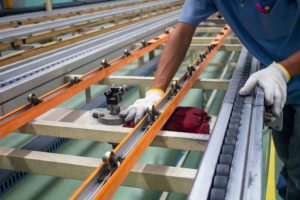Manufacturing Supply Chain Issues: Where Do We Go From Here?
A version of this article was originally published in Food Logistics.
The global supply chain has changed dramatically since the start of the pandemic, from material shortages to labor shortages. Find out how you can bridge the gap.
The global supply chain has changed dramatically since the start of the pandemic – from changes in consumer preferences and demands to recent material shortages. In the height of the Coronavirus disease (COVID-19) in the United States, consumers were mainly at home under tight restrictions. This had an immediate effect on the manufacturing industry, including an increase in demand for toilet paper and personal protective equipment (PPE), and a decrease in demand for specific products geared toward groups of people, such as party size food or beverages.
Now, manufacturing is also witnessing another problem with the supply chain – physical material shortages. Take the semiconductor chip shortage for example – tens of thousands of products been sitting in warehouses, unusable since manufacturers have not been able to get their hands on chips. This begs the question, what other factors are feeding into the shortage and how can manufacturers combat this to bring the needed products to people?
Manufacturing Supply Chain Hurdles and the Worker Shortage
While the manufacturing industry has been facing physical material shortages in recent months, another large factor of the recent supply chain shortage has been the smaller pool of employees.
The United States is currently witnessing a shortage of more than 2 million workers and the industry is desperate to fill these positions in order to keep up with the resurgence of consumer demands.
Deloitte even estimates that these vacant positions could cost the country’s economy more than $1 trillion in the next decade.
It’s not just that there are fewer workers available; it’s also that there is an increased skills gap in the manufacturing industry. Job openings have been growing on a constant basis in recent years, but graduates and people interested in entering the industrial workforce have been steadily declining, which puts a strain on the manufacturing space as a whole and thus on the resiliency of the supply chain.
One of the contributing factors discovered is the lack of digital tools available in the manufacturing industry, which is critical when trying to attract younger generations to the space. Millennials and Generation Z prioritize the availability of digital tools over many other aspects of their employment. In fact, according to recent research conducted by Parsable, more than half reported that they would leave their current job for the opportunity to work in a more modern and digital environment.
By working to close this digital gap and providing frontline workers with technology, manufacturing companies stand a much better chance at retaining their current frontline employees and attracting more talent to the industry, which will be key to combat the skills shortage and increase the talent pool.
Tips on Managing Manufacturing Supply Chain Issues
Along with creating and enabling a larger pool of workers with the needed skills, there are additional aspects the manufacturing industry can be thinking about to lessen the supply chain shortage. While no one could have predicted the COVID-19 pandemic and its effect on the supply chain, this has given companies an opportunity to evaluate old processes and implement a new set of strategies. Evolving procedures and assessing priorities will allow for an increase in business resiliency as the industry moves forward to meet the resurgence in advanced supply chains.
Efficiency is key – It is critical that the frontline workforce be empowered to work more efficiently by implementing digital and scalable solutions. Manufacturing workers can no longer be expected to solely use pen and paper. Emerging technologies that allow workers to cut out unnecessary tasks or shorten the time it takes to complete them will aid in the journey to solve supply chain issues.
Prioritize safety – The pandemic decreased U.S. pork and beef production by 40%, according to CoBank, due to mass facility shutdowns related to worker health and safety incidents. Safety has never been more important, even as we move past COVID-19, and manufacturing needs to prioritize up-leveling safety protocols in order to reduce preventable accidents and repeat incidents.
Increase quality standards – Having high-quality standards is vital for streamlined supply chains. This is a company-wide responsibility and increasing these protocols will ensure better control of processes and services.
Anticipate trends – No one has a crystal ball, but the manufacturing industry should always be looking forward. What consumer trends do companies see on the horizon for the coming months that would affect their supply chains and what they can deliver to their customers? Understanding these trends can put businesses in a better position to revamp and refocus their priorities if needed.
The manufacturing industry is on a precipice, currently facing a massive supply chain shortage as the space works to get back to a sense of normal. A lot of that couldn’t be foreseen and sits outside people’s control. But, by focusing on what can be controlled through a combination of decreasing the skills gap and focusing on efficiencies within their own plants, manufacturers will be in a better position to combat the supply chain shortage both at a talent and industry level.







